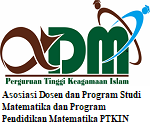Multivariate Adaptive Regression Splines (MARS) for Modeling Student Status at Universitas Terbuka
DOI:
https://doi.org/10.15642/mantik.2021.7.1.51-58Keywords:
Basis function, GCV, Multivariate, Recursive, SplinesAbstract
Multivariate Adaptive Regression Splines (MARS) used to model the active student’s status in the Department of Statistics at Universitas Terbuka and determine the factors that influence the response variable. This study consists of 9 variables, namely gender, age, education, marital status, job, initial registration year, number of registrations, credits, and GPA, but after modeling using the MARS method, the explanatory variable can affect the response variable is the initial registration year. Several registrations, GPA, and credits. Based on the results of the R output and using a 95% confidence interval, each base 1 to 10 function is partially significant with the p-value of the base 1-10 function being smaller than 0.05 and simultaneously with a smaller p-value. of 0.05, so that the above model has a significant effect partially or simultaneously on the response variable. From these results, it is concluded that the MARS model is suitable for determining the factors that affect the active status of students.
Downloads
References
S. Hasanah and S. Permatasari, “METODE KLASIFIKASI JARINGAN SYARAF TIRUAN BACKPROPAGATION PADA MAHASISWA STATISTIKA UNIVERSITAS TERBUKA,” vol. 14, no. 2, pp. 243–252, 2020, doi: 10.30598/barekengvol14iss2pp249-258.
A. Wibowo and M. R. Ridha, “Comparison of Logistic Regression Model and MARS Using Multicollinearity Data Simulation,” JTAM | J. Teor. dan Apl. Mat., vol. 4, no. 1, p. 39, 2020, doi: 10.31764/jtam.v4i1.1801.
S. Park, S. Y. Hamm, H. T. Jeon, and J. Kim, “Evaluation of logistic regression and multivariate adaptive regression spline models for groundwater potential mapping using R and GIS,” Sustain., vol. 9, no. 7, pp. 1–20, 2017, doi: 10.3390/su9071157.
U. Wagschal, Regression analysis, no. March 2014. 2016.
H. Midi, S. K. Sarkar, and S. Rana, “Collinearity diagnostics of binary logistic regression model,” J. Interdiscip. Math., vol. 13, no. 3, pp. 253–267, 2010, doi: 10.1080/09720502.2010.10700699.
C. Mina and E. Barrios, “Profiling Poverty with Multivariate Adaptive Regression Splines,” Development, no. September, 2009, [Online]. Available: http://publication.pids.gov.ph/pubdetails.phtml?code=DP 2009-29.
M. Rosenblatt, “Institute of Mathematical Statistics is collaborating with JSTOR to digitize, preserve, and extend access to The Annals of Statistics. ® www.jstor.org,” Ann. Stat., vol. 19, no. 3, pp. 1403–1433, 1991.
G. W. Weber, I. Batmaz, G. Köksal, P. Taylan, and F. Yerlikaya-Özkurt, “CMARS: A new contribution to nonparametric regression with multivariate adaptive regression splines supported by continuous optimization,” Inverse Probl. Sci. Eng., vol. 20, no. 3, pp. 371–400, 2012, doi: 10.1080/17415977.2011.624770.
L. Y. Chang, “Analysis of bilateral air passenger flows: A non-parametric multivariate adaptive regression spline approach,” J. Air Transp. Manag., vol. 34, pp. 123–130, 2014, doi: 10.1016/j.jairtraman.2013.09.003.
T. Harju, “Derivation of Aircraft Performance Parameters Applying Machine Learning Principles,” 2017, [Online]. Available: www.aalto.fi.
M. Y. Cheng and M. T. Cao, “Accurately predicting building energy performance using evolutionary multivariate adaptive regression splines,” Appl. Soft Comput. J., vol. 22, pp. 178–188, 2014, doi: 10.1016/j.asoc.2014.05.015.
T. S. Lee, C. C. Chiu, Y. C. Chou, and C. J. Lu, “Mining the customer credit using classification and regression tree and multivariate adaptive regression splines,” Comput. Stat. Data Anal., vol. 50, no. 4, pp. 1113–1130, 2006, doi: 10.1016/j.csda.2004.11.006.
S. Hasanah, “Islamic Countries Society of Statistical Sciences,” in Comparison Of Method Classification Artificial Neural Network Back Propagation, Logistic Regression, And Multivariate Adaptive Regression Splines (Mars) (Case Study Data Of Unsecured Loan), 2014, pp. 477–486, [Online]. Available: www.isoss.net.
Y. Zhou and H. Leung, “Predicting object-oriented software maintainability using multivariate adaptive regression splines,” J. Syst. Softw., vol. 80, no. 8, pp. 1349–1361, 2007, doi: 10.1016/j.jss.2006.10.049.
R. Biswas, B. Rai, P. Samui, and S. S. Roy, “Estimating concrete compressive strength using MARS, LSSVM and GP,” Eng. J., vol. 24, no. 2, pp. 41–52, 2020, doi: 10.4186/ej.2020.24.2.41.
S. Sekulic and B. R. Kowalski, “MARS : A TUTORIAL,” vol. 6, no. April, pp. 199–216, 1992.
E. Kartal Koc and H. Bozdogan, “Model selection in multivariate adaptive regression splines (MARS) using information complexity as the fitness function,” Mach. Learn., vol. 101, no. 1–3, pp. 35–58, 2015, doi: 10.1007/s10994-014-5440-5.
Downloads
Published
How to Cite
Issue
Section
License
- Authors retain copyright and grant the journal right of first publication with the work simultaneously licensed under a Creative Commons License that allows others to share the work with an acknowledgment of the work's authorship and initial publication in this journal.
- Authors are able to enter into separate, additional contractual arrangements for the non-exclusive distribution of the journal's published version of the work (e.g., post it to an institutional repository or publish it in a book), with an acknowledgment of its initial publication in this journal.
- Authors are permitted and encouraged to post their work online (e.g., in institutional repositories or on their website) prior to and during the submission process, as it can lead to productive exchanges, as well as earlier and greater citation of published work







.png)




